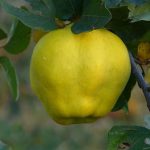 (In Rosaceae) indehiscent simple fruit in which the receptacle or hypanthium has enlarged to enclose the ripened ovary.
(In Rosaceae) indehiscent simple fruit in which the receptacle or hypanthium has enlarged to enclose the ripened ovary.
Ovary inferior, surrounded by fleshy tissue, usually interpreted as a hypanthium, as in the apple or pear.
A fleshy fruit having several seeds (as an apple).
The fleshy but firm fruit of an Apple or Pear, etc, its outer fleshy part, formed from the swollen cup-shaped receptacle of the flower, surrounding the gristly carpels in each of which are one or more seeds (pips).
A type of fruit, for example, apples or quinces, in which the true fruit, with several carpels each containing one or more seeds, is fused to and almost enclosed in a ‘false fruit’ derived from the receptacle (calyx-tube) of the flower, which enlarges greatly as the fruit develops. The pomefruits are this whole class of edible and ornamental fruits in the rose family, principally apples and pears but also including genera such as Sorbus, Amelanchier, Crataegus, Chaenomeles and Mespilus.
A fruit of some members of the rose family (Rosaceae) with the seeds, surrounded by a tough but not woody or stony layer (the ‘core’), embedded in the enlarged fleshy receptacle.
This term is used to describe a type of fleshy fruit, such as an apple or pear, that has seeds enclosed in cases, known as carpels, to form a core. These types of fruits are also commonly referred to as pip fruits, due to the presence of small, hard seeds or pips at the center of the fruit. Apples and pears are two of the most popular types of pip fruits, and are widely enjoyed around the world for their crisp texture and sweet, juicy flavor. Other types of pip fruits include quinces, crabapples, and some varieties of plums and cherries. Whether eaten on their own as a healthy snack or used in a wide range of sweet and savory dishes, pip fruits are a versatile and delicious ingredient that is sure to satisfy any appetite.
